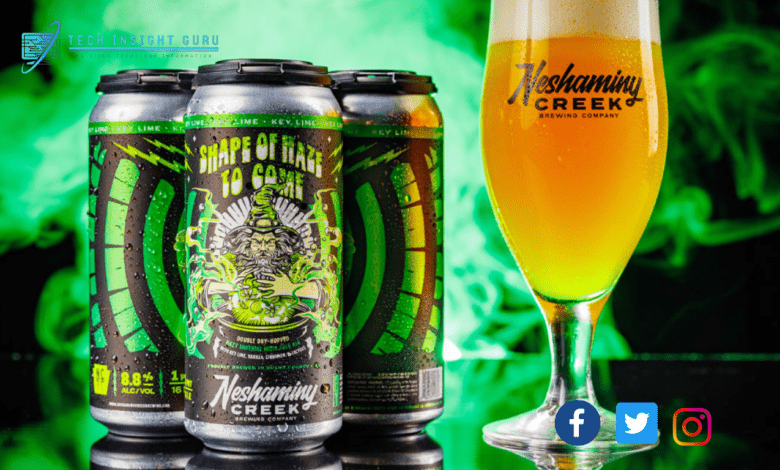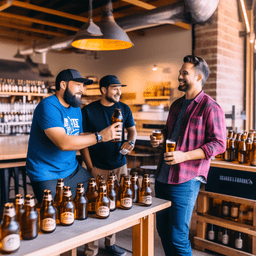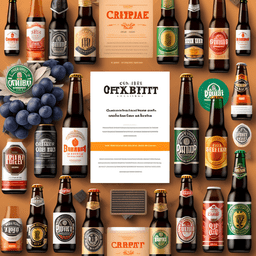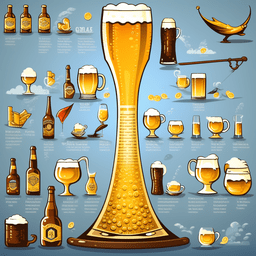
SEO for Craft Breweries Tapping into Beer Enthusiasts 2023

Introduction
For craft breweries, Search Engine Optimization (SEO) is a powerful tool to tap into beer enthusiasts, attract customers, and establish a strong online presence in the competitive world of craft beer With the rising popularity of craft beer and the growing community of beer enthusiasts, optimizing for SEO can significantly enhance the visibility of craft breweries and connect them with a wider audience of beer connoisseurs In this comprehensive guide, we will explore the significance of SEO for craft breweries and provide actionable strategies to tap into beer enthusiasts
1 Identify Your Target Audience and Define Your Craft Beer Niche
The first step in tapping into beer enthusiasts is to identify your target audience, such as craft beer enthusiasts, beer tourists, or individuals seeking unique brews Clearly define your craft beer niche, whether it’s offering distinct beer styles, local ingredients, or brewery experiences, and showcase it throughout your website to resonate with your audience and establish your brand identity
Conduct Market Research:
Start by conducting thorough market research to gain insights into the craft beer industry. Analyze market trends, consumer behavior, and the competitive landscape to identify opportunities and gaps.
Define Demographics:
Clearly define the demographics of your target audience. Consider factors such as age, gender, income level, location, and lifestyle preferences. Understanding the demographics will help you craft beer offerings that appeal to a specific consumer base.
Explore Psychographics:
Dive into psychographics to understand the values, interests, and behaviors of your target audience. Explore their attitudes towards craft beer, their lifestyle choices, and what motivates their beer consumption.
Identify Consumer Preferences:
Determine the preferences of your target audience when it comes to craft beer. This includes beer styles, flavor profiles, brewing techniques, and packaging preferences. Knowing what your audience likes will guide your product development.
Evaluate Local Market Needs:
Assess the local market to identify specific needs and preferences. Consider the cultural and regional aspects that may influence beer consumption. Tailor your craft beer offerings to align with the tastes of the local community.
Consider Craft Beer Trends:
Stay abreast of current and emerging craft beer trends. This includes exploring popular styles, brewing methods, and innovative ingredients. Adapting to trends can make your brewery more appealing to a wider audience.
Define Unique Selling Proposition (USP):
Clearly articulate your brewery’s unique selling proposition. What sets your craft beer apart from others in the market? Whether it’s a distinct flavor profile, brewing process, or a commitment to sustainability, a unique proposition attracts a dedicated audience.
Create Buyer Personas:
Develop detailed buyer personas representing your ideal customers. These personas should encapsulate the characteristics, preferences, and behaviors of different segments within your target audience. Use these personas as reference points for decision-making.
Engage with the Community:
Actively engage with the local and online beer community. Attend beer festivals, join social media groups, and participate in forums to connect with potential customers. Understanding community discussions can provide valuable insights.
Define Your Brewery’s Personality:
Define the personality of your brewery brand. Is it traditional and classic, or modern and experimental? Aligning your brand personality with the preferences of your target audience helps build a stronger connection.
2 Optimize Website Content with Relevant Craft Beer Keywords
Optimize your website content by incorporating relevant craft beer keywords that reflect the beer styles, ingredients, and experiences you offer Use keyword-rich s, meta descriptions, and alt tags for images to improve search discoverability and rank higher in search engine results

3 Create Tempting and Descriptive Beer Descriptions
Create tempting and descriptive beer descriptions that highlight the flavors, aromas, and craftsmanship of your brews Use beer-specific terminology to appeal to beer enthusiasts’ taste buds
Understand Flavor Profiles:
Begin by thoroughly understanding the flavor profiles of your beers. Identify the prominent tastes, aromas, and characteristics that set each brew apart. Consider factors like malt sweetness, hop bitterness, yeast characteristics, and any unique additions or brewing techniques.
Highlight Key Ingredients:
Showcase the key ingredients that contribute to the beer’s flavor. Whether it’s a special hop variety, unique malt blend, or distinct yeast strain, mentioning these elements adds depth to your descriptions.
Use Imaginative Language:
Incorporate imaginative and evocative language to describe the sensory experience of the beer. Paint a vivid picture for the customer by using adjectives that evoke taste, smell, and texture. For example, instead of saying “hoppy,” consider descriptors like “citrus-infused” or “pine-kissed.”
Tell a Story:
Share the story behind each beer. Whether it’s inspired by a local legend, a cultural influence, or a brewing experiment, storytelling adds a layer of intrigue and personal connection to the beer.
Consider Food Pairings:
Suggest food pairings to complement the beer. This helps customers envision the beer in a context and enhances the overall dining or drinking experience. For example, recommend that a robust stout pairs well with chocolate desserts.
Specify Beer Style:
Clearly indicate the beer style in your description. This provides customers with a quick reference point and helps them navigate your menu more efficiently. Whether it’s an IPA, stout, pilsner, or sour, be explicit about the style.
Express ABV and IBU:
Include the Alcohol By Volume (ABV) and International Bitterness Unit (IBU) values in your descriptions. This information gives customers insights into the beer’s strength and bitterness, allowing them to choose based on personal preferences.
Use Flavor Analogies:
Draw comparisons to familiar flavors or experiences to convey the essence of the beer. For instance, if a beer has a tropical fruit character, you might describe it as having “notes of ripe mango and pineapple.”
Create Catchy Names:
If your beers have unique or catchy names, incorporate them into your descriptions. A well-crafted name can capture attention and contribute to the overall allure of the beer.
4 Utilize Long-Tail Keywords for Specific Beer Queries
Incorporate long-tail keywords into your content to target specific search queries related to craft beer, such as “IPA breweries near me” or “best craft beer festivals in [your location]” Long-tail keywords can attract highly targeted traffic and connect you with beer enthusiasts seeking specific brews and events

5 Implement Structured Data for Brewery Events and Offerings
Implement structured data markup to highlight your brewery events, beer releases, and seasonal offerings Structured data can enhance your search results and increase click-through rates
Understand Structured Data:
Familiarize yourself with structured data and its importance for SEO. Structured data is a standardized format that provides additional information to search engines, helping them better understand your content and present it in search results.
Choose a markup format:
Determine the structured data markup format you want to use. Common formats include JSON-LD, Microdata, and RDFa. JSON-LD is often recommended for its simplicity and compatibility with modern web development practices.
Use the Schema.org vocabulary:
Leverage the Schema.org vocabulary, a collaborative initiative by major search engines, that defines the properties and types of structured data related to brewery events and offerings. Schema.org provides specific schemas for events, products, and more.
Identify key data points:
Determine the key data points for your brewery events and offerings that you want to highlight in search results. This may include event dates, locations, beer names, descriptions, prices and any other relevant details.
Apply JSON-LD markup:
If using JSON-LD, embed the markup directly into the HTML of your web page. For example, for a brewery event, you can include a JSON-LD script in the head or body section of your HTML document, specifying structured data properties and values.
6 Leverage Social Media for Beer Enthusiast Engagement
Leverage social media platforms to share enticing beer photos, brewery news, and behind-the-scenes glimpses of your brewing process Social media exposure can lead to increased website traffic and brand recognition
Identify Your Target Platforms:
Determine which social media platforms align best with your brewery’s goals and target audience. Platforms like Instagram, Facebook, Twitter, and TikTok are popular choices for beer-related content.
Create a Consistent Brand Presence:
Establish a consistent and visually appealing brand presence across your social media accounts. Use cohesive branding elements, such as logos, color schemes, and imagery, to create a recognizable and cohesive identity.
Share Behind-the-Scenes Content:
Provide glimpses behind the scenes of your brewery. Share images and videos showcasing the brewing process, the people behind the scenes, and any special events or collaborations. Authenticity resonates with enthusiasts.
Feature Beer Releases and Specials:
Regularly announce and showcase new beer releases, seasonal brews, and special promotions. Build anticipation by creating engaging content around the unique features and flavors of each beer.
Host Virtual Tastings and Events:
Organize virtual beer tastings or live events on social media platforms. Engage with your audience in real-time, answer questions, and encourage participants to share their own tasting experiences. This fosters a sense of community.
Run Contests and Giveaways:
Stimulate participation and excitement by running contests and giveaways. Encourage followers to share their favorite beer-related stories, photos, or recipes for a chance to win brewery merchandise or exclusive access to events.
Create Interactive Polls and Surveys:
Use interactive features like polls and surveys to gather feedback from your audience. Ask them about preferred beer styles, potential collaborations, or upcoming event preferences. This involvement makes enthusiasts feel valued.
Collaborate with Influencers and Beer Bloggers:
Collaborate with beer influencers and bloggers to expand your reach. Influencers can help promote your brewery and engage their followers through sponsored content, reviews, or collaborative projects.
Share Educational Content:
Educate your audience with informative content about beer styles, brewing techniques, and beer-related trivia. Share fun facts, infographics, or short videos that both entertain and enlighten your followers.
Encourage User-Generated Content:
Encourage users to create and share their own content related to your brewery. Establish a branded hashtag and feature user-generated content on your official accounts. This not only engages enthusiasts but also provides authentic promotion.
Respond Promptly to Comments and Messages:
Actively engage with your audience by responding promptly to comments, messages, and mentions. Create a dialogue, express gratitude for positive feedback, and address any concerns or inquiries promptly.
Highlight Beer Pairings and Recipes:
Share beer pairing suggestions and recipes that complement your brews. Encourage followers to experiment with food and beer pairings at home and share their culinary creations.
Utilize Instagram Stories and Reels:
Leverage Instagram Stories and Reels to create engaging and ephemeral content. Use these features to share behind-the-scenes moments, quick tutorials, or playful content that disappears after 24 hours.
Showcase Customer Testimonials:
Feature customer testimonials and reviews on your social media. With permission, share photos and quotes from satisfied customers enjoying your beers. This builds social proof and trust among potential enthusiasts.
7 Collaborate with Beer Influencers and Brewmasters
Collaborate with beer influencers, beer bloggers, and renowned brewmasters to gain exposure and expand your reach within the craft beer community Influencer partnerships can add credibility to your brews
Identify Influencers and Brewmasters:
Conduct thorough research to identify beer influencers and brewmasters whose values and audience align with your brewery. Look for individuals with a genuine passion for craft beer and a strong presence on social media or within the brewing community.
Build Authentic Relationships:
Approach potential collaborators with a focus on building authentic relationships. Engage with their content, share your brewery’s story, and express genuine interest in their expertise and contributions to the craft beer industry.
Personalized Outreach:
When reaching out, craft personalized and genuine messages. Highlight specific aspects of your brewery that resonate with the influencer or brewmaster. Clearly articulate why you believe collaboration would be mutually beneficial.
Offer Unique Experiences:
Provide influencers and brewmasters with unique experiences related to your brewery. This could include exclusive brewery tours, tastings of upcoming releases, or the opportunity to collaborate on a special brew. Unique experiences make collaborations more enticing.
Share Your Brewery’s Story:
Communicate your brewery’s story and values. Brewmasters and influencers are often drawn to breweries with a compelling narrative and a commitment to quality and innovation. Share what sets your brewery apart and why they should be excited to collaborate with you.
Explore Co-Creation Opportunities:
Explore co-creation opportunities that leverage the expertise of brewmasters and the influence of beer influencers. This could involve brewing a special collaboration beer, hosting joint events, or creating engaging content together.
Provide Exclusive Previews:
Offer influencers and brewmasters exclusive previews of upcoming beer releases or events. This not only generates excitement within their audience but also establishes a sense of exclusivity and partnership.
Highlight Shared Values:
Emphasize shared values and interests between your brewery and the influencers or brewmasters. Whether it’s a commitment to sustainability, a love for innovative brewing techniques, or a dedication to community engagement, aligning on values enhances the authenticity of the collaboration.
Create Engaging Content Together:
Collaborate on creating engaging and shareable content. This could include social media posts, blog articles, videos, or live streams that showcase the collaborative process, highlight the unique aspects of your brewery, and provide valuable insights into the world of craft beer.
Cross-Promote Across Platforms:
Cross-promote the collaboration across various platforms. Share the content on both your brewery’s and the collaborator’s social media channels, websites, and newsletters. This cross-promotion expands the reach of the collaboration to diverse audiences.
Utilize Hashtags and Campaigns:
Create custom hashtags and campaigns for the collaboration. Encourage influencers, brewmasters, and their followers to use these hashtags when sharing content related to the collaboration. This fosters a sense of community and amplifies the impact of the collaboration.
Host Joint Events or Tastings:
8 Utilize Video Content for Beer Tastings and Brew Tours
Utilize video content to showcase beer tastings, brewery tours, and interviews with your brewmasters Video content can create an immersive experience for beer enthusiasts
Plan Engaging Video Concepts:
Develop engaging and creative concepts for your video content. Consider themed beer tastings, behind-the-scenes brewery tours, interviews with brewmasters, or educational content about beer styles and brewing processes.
Invest in Quality Production:
Ensure that your video content maintains high production quality. Invest in good lighting, clear audio, and stable camera work. Quality production enhances the professionalism of your brewery and makes the viewing experience more enjoyable.
Introduce Brewery Team Members:
Introduce viewers to key members of your brewery team. Feature brewmasters, brewers, and other staff members in your videos. Personal connections humanize your brewery and create a sense of familiarity with your audience.
Showcase Beer Tasting Sessions:
Host beer tasting sessions on camera. Provide detailed descriptions of the flavors, aromas, and characteristics of each beer. Encourage viewers to participate in the tasting experience by trying the featured beers themselves.
Highlight Brewing Processes:
Take your audience behind the scenes by showcasing brewing processes. Explain the steps involved in brewing different beer styles, highlight unique ingredients, and share insights into your brewery’s approach to craftsmanship.
Create Virtual Brewery Tours:
Develop virtual brewery tours that guide viewers through different areas of your brewery. Highlight the brewhouse, fermentation tanks, barrel aging areas, and any other distinctive features. This provides an immersive experience for viewers.
Educate About Beer Styles:
Educate your audience about various beer styles. Create videos that delve into the characteristics of different styles, the history behind them, and what sets your brewery’s interpretation apart. This educational content enhances the appreciation of your beers.
Host Live Q&A Sessions:
Engage with your audience through live Q&A sessions. Encourage viewers to ask questions about your beers, brewing processes, or the brewery itself. This real-time interaction builds a sense of community and connection.
Collaborate with Influencers:
Collaborate with beer influencers, bloggers, or content creators for joint video projects. This can introduce your brewery to a wider audience and bring fresh perspectives to your video content.
Promote Limited Releases and Events:
Use video content to promote limited beer releases, special events, or festivals hosted by your brewery. Create teaser videos, event highlights, or countdowns to generate excitement among your audience.
Optimize for Different Platforms:
Tailor your video content for different platforms. Consider shorter, attention-grabbing clips for social media, longer-form content for YouTube, and interactive features for live streaming platforms.
Encourage User-Generated Content:
Encourage your audience to create and share their own video content related to your brewery. Run contests, challenges, or virtual events that inspire user-generated content and foster a sense of community.
9 Showcase Customer Reviews and Beer Ratings
Showcase customer reviews and beer ratings to demonstrate the quality and appeal of your craft beers Positive feedback can encourage beer enthusiasts to try your brews
10 Monitor Performance and Adapt
Regularly monitor your website’s SEO performance through analytics tools Analyze website traffic, customer engagement, and keyword rankings to refine your SEO strategies and effectively tap into beer enthusiasts
Conclusion
Mastering SEO is essential for food trucks to boost search visibility, engage customers, and thrive in the mobile dining scene. Identify your audience, optimize with keywords, and create compelling content. Use long-tail keywords, implement local SEO, and leverage social media. Collaborate with influencers, share video experiences, and showcase customer testimonials. Monitor and adapt your SEO for ongoing success. Elevate your online presence, attract foodies, and become a sought-after destination.
